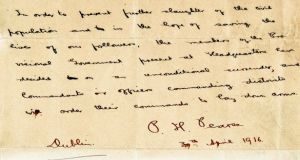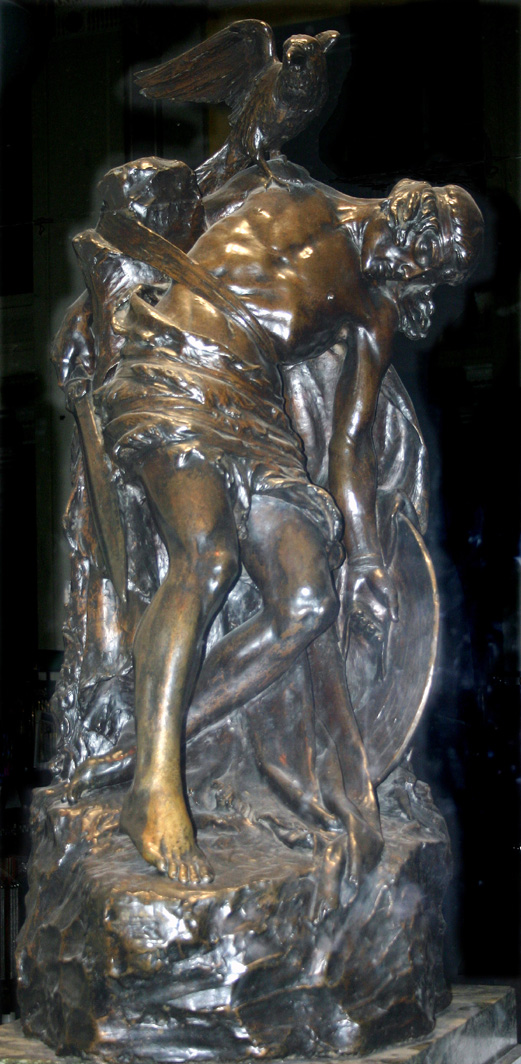Background
The General Post Office, or GPO, is one of the most historically significant sites the Rising’s history. Completed in 1818, the GPO served as the base of the Irish postal service for many years before being taken over as headquarters by many of the Rising’s leaders (“GPO Witness History”). It is often viewed as one of the true symbols of the Rising, even though it did not see the most action during the actual fighting. Groups such as the Cumann na mBan, the Irish Citizen Army, and the Irish Volunteers used the GPO as a meeting place to develop their plans of actions leading up the Rising itself (“GPO Witness History”).

Commemoration History
During the Rising, the GPO was occupied for the entire week (“The GPO-Two Hundred Years”). The Irish Volunteers worked tirelessly to defend it from the British and keep operations running. However, the British troops continued to attack the building, and by Friday it was on fire and had to be evacuated (Jeffery, 81). The building faced some of the highest levels of destruction out of all of the sites of the Easter Rising. Following the fire, leaders and other rebels escaped through the walls of nearby buildings to avoid further attack by the British troops (Jeffery, 83). They moved to new headquarters at 16 Moore Street and continued their resistance. By the next day, they soon realized that they could not keep fighting without more civilian losses, and Padraig Pearse issued the following surrender on Saturday, April 29th. However, much like in the Civil War, the lack of communication meant that the rebels kept fighting into the next day (“The GPO-Two Hundred Years”).

“In order to prevent the further slaughter of Dublin citizens, and in the hope of saving the lives of our followers now surrounded and hopelessly outnumbered, the members of the Provisional Government present at headquarters have agreed to an unconditional surrender, and the commandants of the various districts in the City and County will order their commands to lay down arms.”
Significance Today
The GPO is a powerful symbol of Irish nationalism and pride. While it was completely destroyed during the Rising, it was eventually rebuilt in 1929 (“GPO Witness History”). In recent years it has been turned into a museum to commemorate the Easter Rising and help educate people about Ireland’s rich history, in addition to remaining a post office. However, one part of the building that has remained is the original façade (“The GPO-Two Hundred Years”). The bullet holes in the façade have remained there since 1916, both to help viewers relive the events of the Rising and place themselves in a historical time, and also to remind them of the sacrifices these men made so many years before (“The GPO-Two Hundred Years”).

The statue in the front of the building depicts the death of the mythical hero, Cu Chulainn. His death commemorates the casualties and sacrifices made during the Easter Rising by those so many years before (Irish Times, “Modern Ireland in 100 Artworks”). The various performances and workshops that the GPO hosts also help to remind people of the significance of the Easter Rising, and why it is crucial a part of Irish history that should never be forgotten.

The video above goes into further detail about the 1916 events at the GPO. Courtesy of “Century Ireland”.
Connection to the Civil War
The GPO today is used mainly as a post office, taking away somewhat from its historical meaning. While there are special exhibits about the Rising and programs to memorialize it, its use is mostly practical (“GPO Witness History”). Much like many sites of the Rising, there is little emphasis on its historical significance. By failing to commemorate this place in a way that does justice to the history, much of the significance and memory of those who gave their lives is diminished. Alternatively, sites from the Civil War like Gettysburg or Appomattox have been turned into tourist attractions, and are no longer in practical use today (“Appomattox Court House”). They are largely memorialized and used to educate visitors about the history of the Civil War, and teach people why it is important to commemorate the war still today.
Return to Easter Rising sites.
